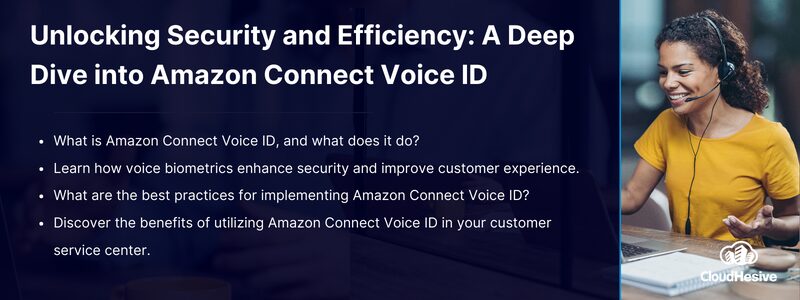Security and authentication using voice biometrics
Users of Amazon Connect benefit from Amazon Connect Voice ID, which enables customer service teams to identify identity accurately. Amazon Connect provides voice biometrics for customer authentication through ML (machine learning) and more.
Most customer service agencies use the time-consuming process of asking questions like date of birth, address, zip code, or other personal details. The problem with asking personal questions is that anyone who’s stolen someone’s wallet or online identity has all that information. Therefore, cyber thieves can use additional customer data to their advantage.
Voice biometrics, on the other hand, uses voice pattern analysis to determine the unique characteristics of a customer’s voice. Amazon Connect uses voice biometrics to identify customers quickly with unique personal characteristics.
Voice biometrics save time, increase authentication accuracy, and automatically screen known fraud watchlists for matches.

The fundamentals of voice biometrics
Voice biometrics work in real-time to authenticate a customer’s identity. For customer service centers, voice biometrics reduce fraud and add an additional level of cybersecurity. The beauty is the customer doesn’t have to do anything special.
Agents can simply get a description of why the customer is calling and have the voice biometrics working in the background. Customers save time by not having to answer questions about personal information. Authentication with voice biometrics happens automatically.
The advantages of using voice biometrics include:
- Increase security to prevent fraud
- Improve customer experience
- Increase agent productivity
- Implement voice ID at any point
The customer experience improves when authentication is performed automatically. The ML technology identifies genuine customer voices during the contact conversation. Voice biometrics shorten calls, making the customer happy and the agent more productive. Amazon Connect Voice ID can also identify auto that’s been synthesized or otherwise manipulated to reduce fraud.
Voice biometrics are flexible. Businesses can use them as secondary authentication to access self-service portals as well. For example, voice biometrics can control access to changing personal information, checking refunds, or verifying shipping status.
Amazon Connect Voice ID: Revolutionizing customer interactions
Amazon Connect offers voice biometrics to enhance both the customer and agent experience. Calls or contact can be quick and efficient without spending time asking personally identifying questions that can be easily compromised.
So, what happens when you add Amazon Connect Voice ID for the firts time?
- Agents must ask the standard questions the first time a customer calls in.
- Then, if the customer consents, Amazon Connect Voice ID records the customer’s voice.
- The voice ID system only needs 30 seconds of speed to create a voiceprint.
- A voiceprint is a mathematical representation of a customer’s voice pattern. It also accounts for speech rhythm, pitch, intonation, and loudness.
- Enrollment is done automatically as the agent asks the customer the standard identification questions. No extra time is necessary.
The next time a customer calls in, Amazon Connect Voice ID requires a ten-second conversation to authenticate the voice. Ten seconds is all it takes to ask the main question – “What are you calling about today?” The ML technology analyzes the voice and generates a score between 0-100, which tells the agent the system’s evaluation of the voice. Agents or service managers can then continue the conversation or, if necessary, ask additional security questions.
For customers unwilling to participate, the system notes the user has opted out within the Amazon Connect dashboard. Amazon Connect does not collect voiceprints when a customer opts out of voice biometrics.
Setting Up Amazon Connect Voice ID
Implementing voice biometricsis done through the Amazon Connect Console, as is any other optional toolset.
The prerequisites for using voice biometrics are:
- Active Amazon Connect instance.
- Access to AWS IAM to define roles and create your custom configuration.
Start by granting all users and groups permissions for identity and access management. The following steps include:
- Create and name the Voice ID domain
- Set an instance alias on the instance page.
- Select the voice ID option to turn it on.
- Read and accept the biometric privacy agreement.
- Sign the BIPA consent acknowledgement agreement.
- Enter the organization’s name for the domain.
- Create and configure an AWS key management service for data encryption
- Select the option to create a KMS key for encryption.
- Choose to use the Symmetric encryption key.
- From the Define Key Administrative Permissions page, define the key usage permissions.
- From the Voice ID main page, select the AWS KMS key you created.
- Add voice ID to your current contact flow settings
- Select to enable voice ID.
- Configure voice ID within your existing contact flow.
- Set the play prompt.
- Set the voice ID.
- Configure contact attributes.
- Choose the options for voice ID use, including enrollment, caller authentication, and fraud detection.
That’s it. Activate and get started.
Best practices for Amazon Connect Voice ID
Before implementing Amazon Connect Voice ID, ensure your team is trained on how to use it or how it impacts the current workflow. Consider setting aside a day or more to test the system to verify it works as you intended.
Setting up Amazon tools can be complicated, and you may not get the settings or features precisely as you want. Plan on making changes and testing them to ensure agent workflow is appropriate.
Leverage the use of fraudster detection. Within voice biometric configuration, businesses can opt to register up to 500 fraudster voices to a watchlist that is detected in real-time. You can also set the fraud risk score and provide it immediately to agents so they can provide additional security measures or end the call.
Consider creating a custom authentication workflow for your team through Amazon Connect Streams API. The Streams API includes automated support for customer enrollment and opt-outs with the click of a button within the standard Amazon Connect interface.
The Streams API also performs call re-authentication when an agent detects possible fraud or when a secondary person takes over a call. Agents can easily call for help or request a new verification with ease.
Training and testing a newly implemented system are critical for long-term success. Make sure time is set aside to train agents on the changes to their call workflow. Additionally, spend time testing the workflow before it goes live. Training and testing ensure agents are prepared and prevent customers from being stuck on calls while agents are training.
Ready to level up your customer support?
Amazon Connect helps you create a productive and efficient customer contact experience. Add to the quality of your service with additional security to prevent fraud or identity theft. Voice biometrics can be integrated into your existing workflows.
The benefits of enabling voice biometrics include added security, increased agent productivity, and improvement in customer service levels.
Prefer the benefit of working with an Amazon Connect expert? CloudHesive provides a business with comprehensive support to create and deploy exceptional and efficient customer support solutions.
As an Amazon Managed Services partner and Amazon Premier Partner, we help any organization experience the benefits and power of Amazon Connect and more.
Learn about our solutions like ConnectPath CX to improve customer satisfaction through consistent and personalized customer service.



